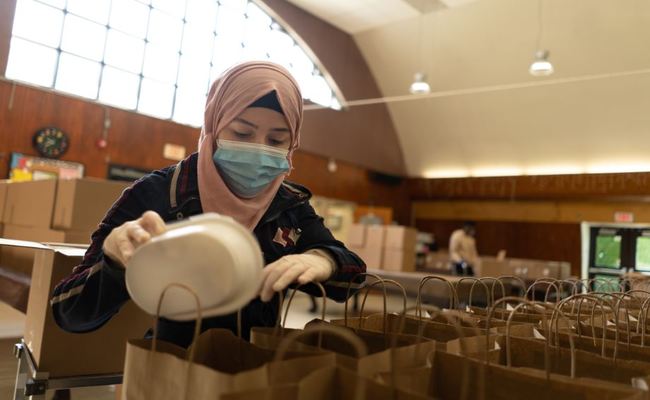Photo Credit: A. Oberstadt/IRC
The COVID-19 pandemic has caused profound disruption across the globe, including in the U.S. As a result of the crisis, resettlement agencies are seeing a sharp rise in food insecurity due to loss of income, breakdown of social support systems, shortages of food, and complications in accessing existing or additional food aid or government financial support. Trends also point to longer-term problems within these communities due to lack of access to health services. These factors may impact health more generally and further contribute to the negative cycle of food insecurity and health disparity.
“Food security means that all people, at all times, have physical, social, and economic access to sufficient, safe, and nutritious food that meets their food preferences and dietary needs for an active and healthy life.” Food and Agriculture Organization (FAO) of the United Nations, 1996.
A new survey from the University of Arkansas found that more than 38% of people were food insecure nationally (up from 11% one year ago). Another study in April 2020, from The Hamilton Project, found that households with children are experiencing higher rates of food insecurity due to the COVID-19 crisis.
Resettlement agencies and local community-based organizations are supporting new American populations and their communities with cash and food assistance and unemployment support. The recommendations below are intended for any organizations working with populations at risk of moderate to serious food insecurity, including refugees, asylees, and other ORR-eligible populations.
1. Map the local food supply:
It is important to understand the food resources available locally and how some of these have shifted since March 2020 in response to pandemic conditions. Supermarkets, corner stores, farmers markets, CSAs, food pantries, school lunch programs, and restaurants have adapted various strategies for serving the public. You can search a national map of food resources from WhyHunger by entering your zip code here.
What this looks like in action:
- Investigate and update local resource lists of emergency and other accessible food sources
- Conduct regular communication with clients and community leaders about food resources
- Coordinate with local actors in any food related response for greater impact and to reduce duplication of efforts
2. Understand clients’ needs for food:
When planning a food security intervention, create a snapshot of current client needs and barriers. Being food secure requires that conditions across four pathways are met:
- a person has the means to access safe, sufficient, healthy, and culturally appropriate food
- food is available locally in shops, markets, or through donation
- the way the person utilizes (prepares and handles) the food is safe and preserves nutritious content
- food resources are stable
The COVID-19 crisis has presented a multitude of barriers across these four pathways, including: inability to leave the house, lack of income, inability to order online, lack of safe transportation, illness, and challenges accessing benefits and/or school meals.
What this looks like in action:
- Develop key food security questions to guide client conversations. Note that cultural preferences and dietary practices influence the understanding of hunger and the concept of “sufficient food.” Your questions should address quality and quantity of food as well as income available for food and other expenses. For example:
-
-
- How many days of food does your family currently have? Describe the types of foods you currently have in your fridge and pantry.
- Do you feel that you and your family are eating enough? If no, what has decreased? Smaller meals? Skipped meals? Less of a certain key item of food like meat, rice, or beans?
- How much money do you have for food currently?
- Where do you buy food currently?
- Do you access food donation like food pantry? If no, why not?
- Are you enrolled in SNAP (WIC, SSI, as applicable)? If not, why not?
- Have you recently lost income? Applied for unemployment?
-
- Check in with clients regularly. See this sample flow chart for a process you might use:

- Once the most urgent food needs (6-48 hours) are met via direct food assistance, it is important to provide clients with longer-term support. This is best provided in two ways: 1) gift cards/pre-loaded ATM cards or 2) assistance via Electronic Benefits Transfer (EBT) (such as SNAP, WIC, or SSI). Both of these types of support provide dignity and choice for the client to meet their own needs. However, they require for clients to be able to access points of sale, and for food to be available at those locations.
3. Engage with project staff and partners for a coordinated, sustainable solution:
Many organizations and staff are finding themselves with new roles and responsibilities as the crisis has shifted. Coordinating internally and with external partners is key for a comprehensive, community-level response.
What this looks like in action:
- Gather feedback from the food insecure community about their concerns and needs, as well as ideas around what a food response should look like.
- Map local programs/partners through stakeholder interviews and desk research. See Switchboard’s materials on community resource mapping as a starting point.
- Establish a food security champion or working group within your department/organization to facilitate information gathering, referrals, and to circulate the most recent information and resources internally
Longer-Term Planning
As the crisis continues, pre-existing barriers to healthy food consumption will likely grow. Refugee and other new American populations often live in areas with insufficient access to healthy food options, and the pandemic conditions will only exacerbate the problem. Longer-term food security responses need to include a diverse list of options that source from the local food system. Consider evidence-based responses such as SNAP match programs, Fruit and Vegetable Prescription programs, and community health worker (CHW) programs. Additionally, organizations can link clients to USDA’s Food and Nutrition Service (FNS) programs, including FNS actions to respond to COVID-19 and general food distribution programs. These responses will improve access to fresh and nutritious produce and healthy eating knowledge, helping to shape longer-term community resilience.










